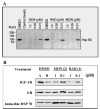Search for Hsp90 inhibitors with potential anticancer activity: isolation and SAR studies of radicicol and monocillin I from two plant-associated fungi of the Sonoran desert
- PMID: 16499313
- PMCID: PMC1876775
- DOI: 10.1021/np058095b
Search for Hsp90 inhibitors with potential anticancer activity: isolation and SAR studies of radicicol and monocillin I from two plant-associated fungi of the Sonoran desert
Abstract
In an effort to discover small molecule inhibitors of Hsp90, we have screened over 500 EtOAc extracts of Sonoran desert plant-associated fungi using a two-stage strategy consisting of a primary cell-based heat shock induction assay (HSIA) followed by a secondary biochemical luciferase refolding assay (LRA). Bioassay-guided fractionation of extracts active in these assays derived from Chaetomium chiversii and Paraphaeosphaeria quadriseptata furnished the Hsp90 inhibitors radicicol (1) and monocillin I (2), respectively. In SAR studies, 1, 2, and their analogues, 3-16, were evaluated in these assays, and the antiproliferative activity of compounds active in both assays was determined using the breast cancer cell line MCF-7. Radicicol and monocillin I were also evaluated in a solid-phase competition assay for their ability to bind Hsp90 and to deplete cellular levels of two known Hsp90 client proteins with relevance to breast cancer, estrogen receptor (ER), and the type 1 insulin-like growth factor receptor (IGF-1R). Some inferences on SAR were made considering the crystal structure of the N-terminus of yeast Hsp90 bound to 1 and the observed biological activities of 1-16. Isolation of radicicol and monocillin I in this study provides evidence that we have developed an effective strategy for discovering natural product-based Hsp90 inhibitors with potential anticancer activity.
Figures






References
Publication types
MeSH terms
Substances
Grants and funding
LinkOut - more resources
Full Text Sources
Other Literature Sources
Molecular Biology Databases
Miscellaneous

